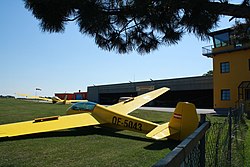Spitzerberg airfield
| Spitzerberg Airfield | |
|---|---|

|
|
| Characteristics | |
| ICAO code | LOAS |
| Coordinates | |
| Height above MSL | 181 m (594 ft ) |
| Transport links | |
| Distance from the city center | 1.5 km north of Prellenkirchen |
| Street | L167 |
| Local transport | Verkehrsbund Ostregion |
| Basic data | |
| operator | Red Bull Air Race GmbH |
| Terminals | 1 |
| Start-and runway | |
| 15/33 | 700 m × 20 m grass |
| website | |
| https://www.spitzerberg.at | |
The Spitzerberg airfield ( ICAO code : LOAS , also Spitzerberg Airfield ) is located on the eastern edge of Lower Austria on the border with Slovakia and is one of the oldest aviation centers in Austria .
It takes its name from the Spitzerberg next to the airfield , a 302 m high elevation which, as part of the Hundsheimer Mountains, belongs to the foothills of the Little Carpathians .
Pilot information
Location : approx. 5.5 km SSE of the Danube bridge Bad Deutsch-Altenburg (Lower Austria / Austria)
Radio frequency : 122.080 (122.380)
The beginnings of aviation
Until 1929, the Spitzerberg was nothing more than a landscape elevation of no particular significance. Since that time, however, the mountain and, subsequently, the Hundsheimer Kogel have gained in sporting interest. This was a very unusual sport at the time, namely motorless flight.
The first group to use the Spitzerberg site was the Sports Aviation Association in the Austrian Aero Club. In the spring of 1929, the first gliding flights were carried out from the slopes of the Spitzerberg and the "neighboring mountain", the Hundsheimer Kogel. A memorial plaque on the Hundsheimer Kogel, symbolically guarded by a stone eagle, reminds of this time.
Development into a flight and training center
As early as 1931, the first continuous flight of 2 hours and 23 minutes (take-off elevation 250-300 m) took place in a disguised "pupil" on the slopes of the Hundsheimer Kogel. This was the beginning of a lively glider flight business in the 30s, which attracted countless clubs. Favored by the optimal conditions, many national and international records fell during this time that were set from the Spitzerberg (e.g. 1937: Austrian distance record 157 km, endurance record single-seater 27 h 50 min, 1938: endurance record double-seater: 40 h 38 min) .
In 1936 the Spitzerberg glider pilot's home, including a spacious hangar, was built and inaugurated, and was in operation until the end of 1939. After that, after detailed planning (draft by architect Christl), the expansion of the airfield into a flying school is tackled. Finally, on October 19, 1940, the Spitzerberg Reich Sailing School was opened and given its intended purpose. The building complex and the airfield still form the core of today's aviation facility.
the post war period
The buildings are badly damaged by war and post-war events. As a ruin, the main building was barely habitable, the side wings were considered ready to be demolished. In 1946, after lengthy negotiations, the remaining Spitzerberg buildings were handed over to the Federal Ministry of Education to save them from deterioration.
In 1950 the "Austrian Aero Club" was founded and in 1951 the Lower Austrian Regional Association. At the end of 1953, restoration work and expansion of the school began. After the conclusion of the state treaty, the “Bundessportschule Spitzerberg” was officially opened on October 2, 1955.
When the school was fully operational, an influx of glider pilot groups from Vienna, who had to stay on the ground during the Russian occupation, began almost suddenly.
Since 1958 new sailplane pilots have been trained in 3-week intensive courses. This type of training has proven itself to this day and is only offered on the Spitzerberg.
Since October 2016 the operator has been Red Bull Air Race GmbH based in Fuschl am See.
Flying training today
The local flight school is currently run by an association. This club is the Aviation Center Spitzerberg (FSZ), whose chairman is Wenighofer Rudolf.
literature
Reinhard Keimel , glider flight on the Spitzerberg and Hundsheimer Kogel . Sutton Verlag, ISBN 3-86680-595-0







